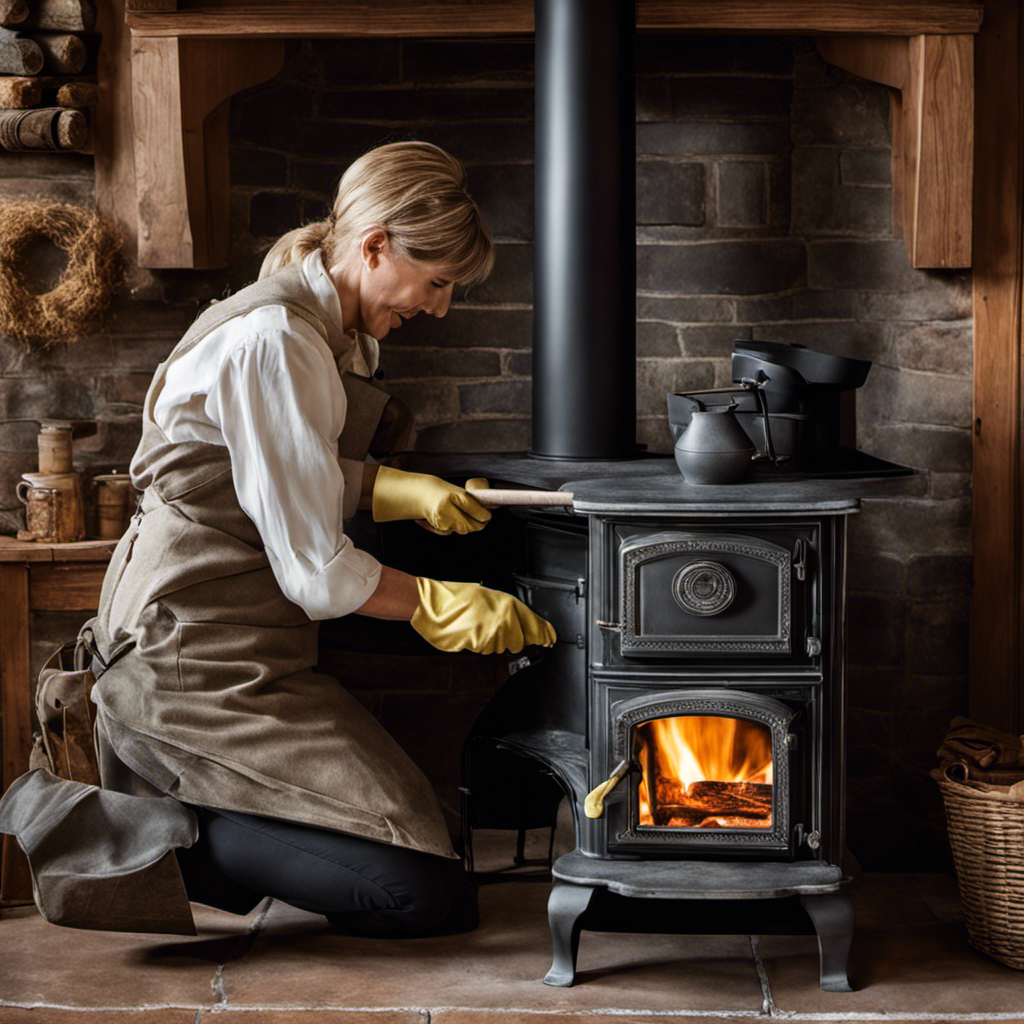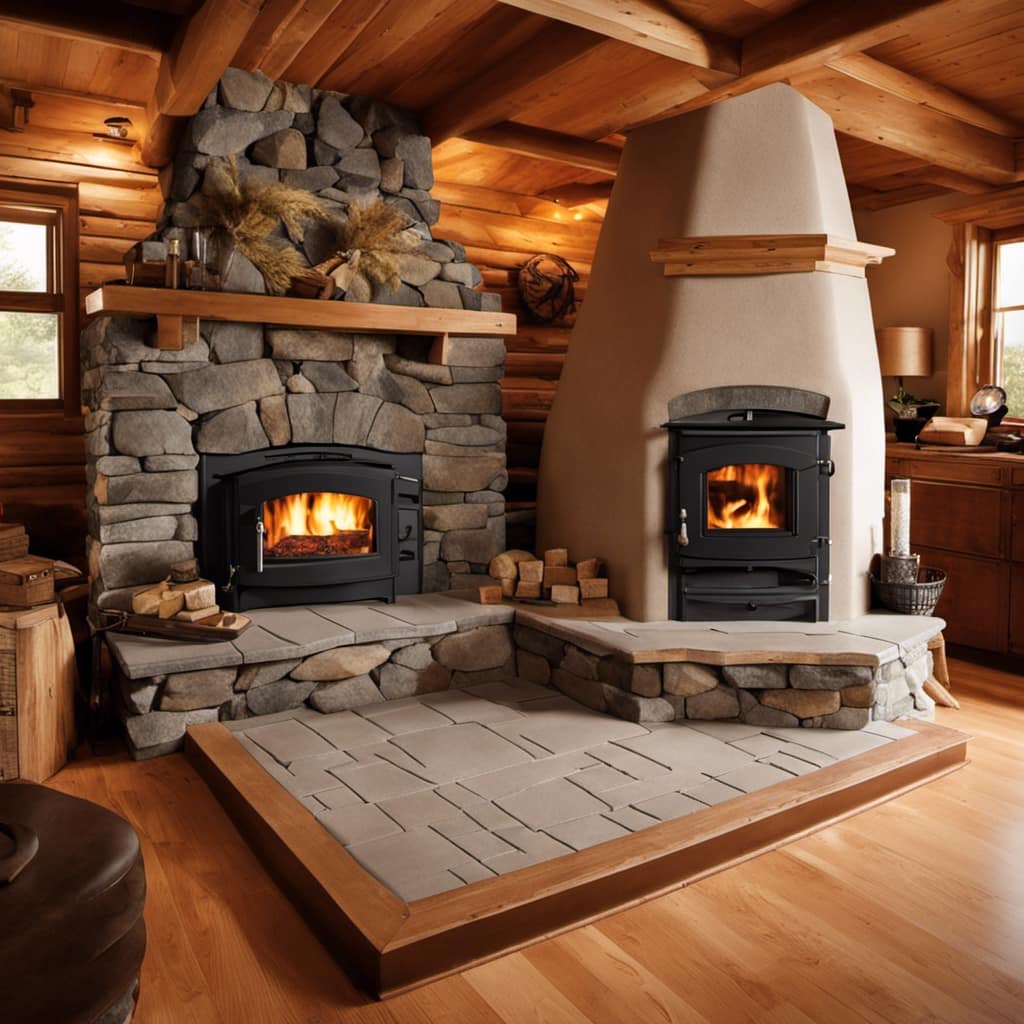As an experienced enthusiast of wood stoves, I’ve unlocked the key to keeping a soapstone wood stove in pristine shape. Let me walk you through the necessary procedures for the cleaning and maintenance of this sophisticated heating appliance.
From preparing the stove for cleaning to removing stubborn stains and ensuring the glass door and metal parts shine, I’ll provide you with expert tips to keep your soapstone wood stove looking brand new.
Get ready to enjoy a well-maintained and efficient stove that adds elegance to any space.
Key Takeaways
- Wear protective gloves and clothing when cleaning the soapstone wood stove.
- Use a mixture of vinegar and water to remove soot and grime from the stove’s surface.
- Create a paste of baking soda and water for tougher stains and apply it to the affected areas.
- Clean the glass door with a damp cloth and use a specialized metal cleaner for the metal parts of the stove.
Preparing the Soapstone Wood Stove for Cleaning
I need to make sure the soapstone wood stove is ready for cleaning.
Before I begin the actual cleaning process, there are a few pre-cleaning steps that I always follow to ensure the best results.
Firstly, I make sure to wear protective gloves and clothing to keep myself safe from any potential burns or accidents.
Next, I remove all the ashes and debris from the stove using a metal ash shovel and a brush. This step is important as it allows for better access to the stove’s interior.
Once the ashes are removed, I inspect the stove for any signs of damage or wear, such as cracks or loose tiles.
Lastly, I gather all the necessary tools, including a soft cloth, a mild soap solution, and a scrub brush, to properly clean the soapstone surface.
Removing Soot and Grime From the Wood Stove
To maintain its efficiency, regular removal of soot and grime is necessary. As someone who’s cleaned my soapstone wood stove for years, I’ve learned a few effective cleaning techniques and natural cleaning solutions that are worth sharing.
When it comes to removing soot and grime from the wood stove, it’s important to use gentle yet effective methods that won’t damage the soapstone surface. One of the best natural solutions is a mixture of vinegar and water. Simply spray the solution onto the soot and grime, let it sit for a few minutes, and then scrub it off with a soft brush or sponge.
For tougher stains, you can also try using a paste made from baking soda and water. These natural cleaning solutions will leave your soapstone wood stove looking clean and shiny without any harmful chemicals.
Tackling Stubborn Stains on the Soapstone Surface
Removing stubborn stains from the surface can be challenging, but with a combination of baking soda and water, it’s possible to effectively tackle them. I’ve found this method to be incredibly effective in removing soap scum and other tough stains from my soapstone surfaces.
Here’s how I do it:
- Create a paste by mixing equal parts baking soda and water.
- Apply the paste to the stained area and let it sit for about 15 minutes.
- Gently scrub the area using a soft brush or sponge.
- Rinse the surface thoroughly with water and wipe it dry.
Using natural cleaning products like baking soda not only helps remove stubborn stains but also ensures that no harmful chemicals are left behind. I’ve been using this method for years and it has never failed me.
Give it a try and see the difference it makes in restoring the beauty of your soapstone surfaces.
Cleaning the Glass Door and Metal Parts of the Stove
When it comes to maintaining the glass door and metal parts of my stove, regular wiping with a damp cloth keeps them looking shiny and free of grease. However, there are a few additional steps I take to ensure they stay in pristine condition. First, I clean the ashtray regularly to prevent buildup and odors. I simply remove it from the stove, empty the ashes into a designated container, and wipe it clean with a damp cloth. For polishing the metal parts, I use a specialized metal cleaner and a soft cloth. I apply the cleaner to the cloth and gently rub it onto the metal surfaces, ensuring even coverage. Then, I buff it off with a clean cloth to reveal a beautiful shine. By following these steps, I keep my stove looking brand new.
| Steps to Clean the Glass Door and Metal Parts | |
|---|---|
| 1. | Wipe the glass door with a damp cloth. |
| 2. | Use a specialized metal cleaner on the metal parts. |
| 3. | Apply the cleaner to a soft cloth and gently rub it onto the metal surfaces. |
| 4. | Buff off the cleaner with a clean cloth for a shiny finish. |
Proper Maintenance and Care for Your Soapstone Wood Stove
Maintaining my soapstone wood stove involves regular inspection and upkeep to ensure it performs efficiently and lasts for years to come. Here are some important steps I take to maintain my soapstone wood stove:
- Clean the exterior regularly with a soft cloth and mild soap to remove any dirt or debris.
- Inspect the soapstone for any cracks or damage, and repair them promptly to prevent further issues.
- Clean the stovepipe and chimney to remove any creosote buildup, which can reduce efficiency and pose a fire hazard.
- Apply a high-temperature paint or sealant to any exposed metal parts to prevent rust and corrosion.
By following these maintenance steps, I can keep my soapstone wood stove in optimal condition and enjoy its warmth and efficiency for many years.
Preventing rust on soapstone wood stoves is essential to ensure their longevity and safe operation.
Frequently Asked Questions
Can I Use Regular Household Cleaners to Clean My Soapstone Wood Stove?
Regular household cleaners may not be the best option for cleaning a soapstone wood stove. Instead, consider using eco-friendly cleaning alternatives that are specifically designed for this type of stove.
How Often Should I Clean My Soapstone Wood Stove?
I clean my soapstone wood stove every 1-2 months to keep it in good condition. Regular cleaning helps prevent buildup and ensures efficient burning. Follow the steps for cleaning a soapstone wood stove to maintain its beauty and functionality.
Is It Necessary to Remove All the Ashes Before Cleaning the Stove?
Before cleaning my soapstone wood stove, I always remove all the ashes. It’s necessary for safety reasons and to ensure proper cleaning. Did you know that a dirty stove can decrease its efficiency by up to 30%?
Can I Use a Power Washer to Clean My Soapstone Wood Stove?
Using a power washer to clean a soapstone wood stove is not recommended. It can damage the delicate soapstone surface. Instead, consider using alternative cleaning methods like wiping with a damp cloth or using a mild soap solution. Safety first!
How Long Does It Take for the Stove to Cool Down Before I Can Start Cleaning It?
Before cleaning my soapstone wood stove, I make sure to safely handle hot surfaces. I wait until there are no signs of heat, such as residual warmth or steam, to ensure it has cooled down enough.
Conclusion
After following these steps, your soapstone wood stove will be sparkling clean and ready to provide you with cozy warmth for many more seasons to come.
You’ll be amazed at how effortlessly you can remove even the toughest stains and grime from the soapstone surface.
With proper maintenance and care, your wood stove will continue to be a beautiful and functional addition to your home.
So go ahead, give your soapstone wood stove the cleaning it deserves and enjoy the satisfaction of a job well done.











